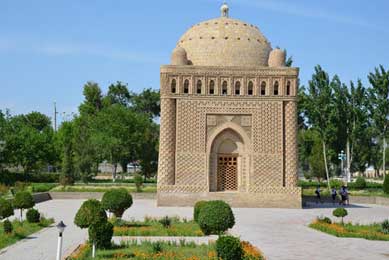(Makhbara Somoniyon, Ismoil Somoniy maqbarasi) the monument of early medieval architecture located in the historic center of Bukhara, in the park broken on the place of the ancient cemetery. The mausoleum was under construction in the 9th century (between 892 and 943). It is found and restored in the 20th century. Is one of architectural masterpieces of Central Asia and a pearl of world architecture? In the mausoleum, there are three burials, one of which belongs to Ahmad ibn Ismail, Ismail Samani's son.
There is no grave of Ismail, the builder of the mausoleum and the founder of the Samanidsky dynasty, perhaps, in the mausoleum. Till the 20th century the mausoleum was almost completely closed by an occupation layer.
Sacral sense
The architectural appearance of the mausoleum is defined by exclusively ancient traditions of perception of the world around. At the beginning of human history in the Northern hemisphere of Earth of people originally allocated four directions, which defined his location in space and helped to be guided with ordinary life. The East and the West — places, from where the Sun ascends and where comes. A pole star — the only "motionless" star indicating the direction the North at night when trade caravans started on on ways. The South — it is Midday — the direction opposite to a shadow to the Sun at noon when the shadow has the smallest length and in the afternoon is the exact index on the North. Having early found "four" — "chor" the fixed points of space, the person perceived the World as the square plane having "four" corners and "four" horizons. At the same time night a dome hemisphere, leaning on terra firma, represented sky. In ancient cultural tradition of the Buddhism Earth on which the person lives is presented in the form Cuba. Thus, the mausoleum — the cube covered with a dome hemisphere is the visible embodiment and the reduced World Model. It also defines architectural canons of a certain culture in certain historical time.
Architecture
This monument marks the beginning of a new era in development of the Central Asian architecture revived after the Arab gain. It is obvious that on the ancient earth ancient Sughd traditions, but already in new quality continued to develop: technology of construction from a burned brick, its constructive and art opportunities, means of architectural expressiveness are a merit of modern times though bear in themselves the habitual "sign system" coming from pre-Islamic culture. Having very small sizes and height, the mausoleum makes exclusively strong impression on the viewer. Undoubtedly, this work by the architect genius. The tremendous effect of perception of construction is reached meanwhile by extremely easy ways, without considerable costs of any decorative finishing materials, such as color smalt or tiles which here just are absent. The classical form, faultless proportions and openwork ligature of a decorative bricklaying created the master's hand a masterpiece which the people of various countries and cultures admire already several centuries. This mausoleum proves the truth that original art is not subject to time and is clear and close to any person, irrespective of his social origin, education and national culture. Giving due respect to the architect on whose plan the mausoleum was built, never you should forget that durability and durability of a construction we are obliged to art of unknown master builders.




